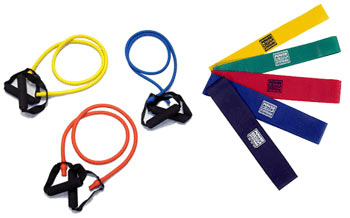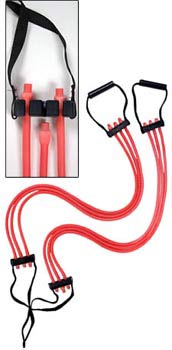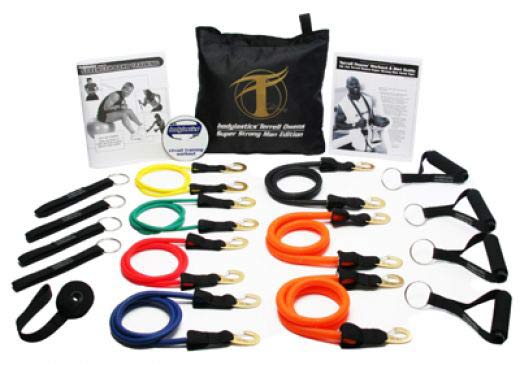- Like
- SHARE
- Digg
- Del
- Tumblr
- VKontakte
- Flattr
- Buffer
- Love This
- Save
- Odnoklassniki
- Meneame
- Blogger
- Amazon
- Yahoo Mail
- Gmail
- AOL
- Newsvine
- HackerNews
- Evernote
- MySpace
- Mail.ru
- Viadeo
- Line
- Comments
- Yummly
- SMS
- Viber
- Telegram
- JOIN
- Skype
- Facebook Messenger
- Kakao
- LiveJournal
- Yammer
- Edgar
- Fintel
- Mix
- Instapaper
- Copy Link
Don’t Make the HUGE MISTAKE of Underestimating the Power of Resistance Bands
Jump Down to the Videos of the Resistance Band Exercises
Resistance Band Exercises Can Serve Many Different Functions
First of all, the resistance provided by tubes or bands is different from that of free weights and body weight.
Since the material which makes up the bands stretches, the further the band stretches, the more resistance is provided. This is useful because there will be the most resistance at the end of the range of motion of any exercise.
Resistance bands can also be added to traditional strength training barbell exercises to increase the resistance towards the end of range of motion.
What Are the Benefits of Resistance Band Exercises ?
Resistance Training Anywhere
Perhaps the biggest benefit of resistance band exercises is the ability to take your workout on the road. Since the bands take up very little space, you can even pack them in your carry-on while you travel for work or vacation.
As a personal trainer, resistance bands provide a valuable tool for mobile training if the sessions are done away from the gym, as resistance tube exercises can be performed at home, on the beach, and even under water!
You Can Use Resistance Band Exercises to Achieve a Variety of Health and Fitness Goals
 Resistance band exercises are simply another form of weight (resistance) training through which you can build strength and muscular endurance and tone your body. If you think there are only a few resistance band exercises, you are sadly mistaken, as you can create exercises on the fly or simply add on to exercises existing in your workout program.
Resistance band exercises are simply another form of weight (resistance) training through which you can build strength and muscular endurance and tone your body. If you think there are only a few resistance band exercises, you are sadly mistaken, as you can create exercises on the fly or simply add on to exercises existing in your workout program.
Resistance Bands Can Provide Very Light to Very Heavy Resistance
You can add multiple bands or tubes together to increase the resistance and this ability is virtually limitless. You can even create enough resistance with bands and tubes to support your body weight for total body exercises.
You can also find special resistance tubes which allow you to connect resistance bands to sturdy handles which increase the number of resistance band exercises you can do because the resistance is enough to support your body weight.
What Are Some Resistance Band Exercises?
You can create workouts solely with resistance band exercises or you can add other types of resistance training, calisthenic exercises, and cardio exercises with the resistance band exercises to create dynamic, intense beginner to advanced workouts.
Warm Up
It is always important to remember that a general warm-up is very important for getting your body ready for intense exercise. The purpose of a general warm-up is to circulate the blood into your periphery and loosen up your muscles and joints. Always perform a general warm up before any kind of physical activity. Resistance band exercises are no exception. You should perform 5-10 minutes of aerobic activity with large muscles, i.e. walking, bicycling, etc. before you start resistance tube exercises or any other workout.

Core / Abs
You can use the resistance bands alone or in combination with other equipment to add resistance to core and abdominal exercises. As with all core and ab exercises, always make sure you use proper form and are able to do the exercise properly before you try to add resistance with a tube or band.
Use tubes with any of the best abdominal exercises to increase the resistance and overall difficulty of the exercises. Resistance band exercises work best if they make up a part of your workout program and you use them alongside other forms of exercise.
Resistance Band Twists
Resistance band twists are an important exercise because they strengthen your muscles in the transverse plane.
Your oblique muscles are important to developing functional and core strength as well as helping to keep your waist line slim.
Start: Attach the bands to a secure object and walk away from the attachment until you feel tension in the band.
Stand up tall with your legs slightly bent and feet shoulder width apart. Extend your arms forward in front of your chest. Walk to the side so your hands are pointing toward the origin of the resistance.
Begin the motion: Keeping your core drawn in and your arms fully extended, turn away from the origin of the resistance band.
Try to keep your hips from moving so you are isolating your obliques which rotate your torso at the waist. Slowly return the band to the original position
Modifications: To increase the difficulty of this exercise you can decrease the stability of your base. To do this, simply move your feet together until they are touching, or stand on an unstable object such as a BOSU ball or balance disc.
Resistance Band Abdominal Crunches
You can easily increase the difficulty of the standard abdominal crunch by using a resistance band.
You do not need any extra equipment, but BOSU balls and stability balls help with increasing range of motion and effectiveness of standard floor crunches.
Start: Attach the resistance tube to a low point. Walk away from the attachment until there is some tension from the resistance tube.
Lie down facing away from the resistance tube and hold the hand behind your back.
Begin the motion: Stay under control, draw in your core and lift your upper body up towards the ceiling and forward.
Slowly return to the original position and repeat the motion.
Modifications: Stepping further away from the origin of the tube attachment is the easiest way to increase resistance and make the resistance band exercises more difficult. Changing the surface (ball or bench) in which you are doing crunches on is another way.
 Back
Back
Your back muscles are one of your three large muscle groups alongside your chest and legs. It is very important to strengthen the muscles in your upper and lower back for overall functionality and for increasing the effectiveness of all chest and leg exercises.
If you have limited gym equipment options, a resistance band is essential for working the muscles in your upper back if you only use body weight exercises and cannot perform pull-ups.
Resistance Band Rows
Rows are a very important resistance band exercise.
If preformed properly, rows strengthen the muscles in your upper middle back which not only help you maintain proper posture, but also help you build your full body properly.
Start: Attach the heavy resistance band to a doorknob or secure object. Walk away from the door until you feel the band become tight.
Assume an athletic stance, keeping your shoulders in neutral position, do not let them protract or fall forward.
Begin the motion: Keeping your shoulders, back in and wrists neutral alignment pull your hands towards your ribcage, leading with your elbows.
Retract (squeeze together) your shoulder blades without shrugging your shoulders for a split second, then slowly return your hands to the original position without letting your shoulders protract and repeat the motion.
Modifications: Walk back further away from the attachment of the cable for more resistance. If you would like to increase stabilization requirements for the exercise, you can stand on an unstable surface such as a BOSU ball, Airex pad or balance disc.
Resistance Band Lat Pulldowns
Lat pull downs are one of the most common exercises to perform for the large back muscle group and its synergists. Back synergists include biceps, brachioradialis and forearms muscles.
Start: Attach the cable attachment to something high such as the top of a door. Sit on the floor, stool, bench, stability ball, or whatever is available.
The bands should be taut with your arms fully extended in front and above your head.
Begin the motion: Pull the cables down towards you and your elbows back towards your body.
Squeeze your shoulder blades together as you pull your elbows as far down and back as you can.
After you squeeze your lats for a split second, slowly return your handles under tension to the original position and repeat.
Modifications: You can vary the angle of the lat pull down by moving the resistance band or the angle of your torso in relation to the band. You can also perform this exercise from a prone (face down) position or using a stability ball if you are not able to anchor the resistance band to a high spot.
Chest
Chest exercises are important for everyone: men and women, strong and weak, experienced and novice lifters. The chest muscles comprise one of your body’s 3 major large muscle groups.
Performing resistance band exercises for the chest allows you to have the most resistance towards the end of the range of motion, so they can help people who have trouble “locking out” the bench press.
Resistance Band Chest Press
Any upper body resistance band workout should include the chest press. You should use some form of chest press as one of the base exercises of any workout program.
Resistance band chest press can take the place of push-ups for people who are too heavy or weak to do pushups, or they can be used at the end of a workout to finish off the muscle group.
Start: Grab the resistance bands or tube handles and turn away from where the bands are anchored.
Assume a staggered stance with one foot in front of the other and keep your hands at around nipple level at the side of your chest.
You can have the resistance band under your arm or above your arm; it is a matter of personal preference.
Begin the motion: Keeping your core tight, shoulders squeezed back and legs slightly bent, push your hands directly forward and to the center until the handles or your hands touch. You can also press straight forward, the main form tip is to make sure you do not protract (move forward) your shoulders.
Modifications: Simply walk farther forward to increase the resistance of resistance band exercises. You can also perform one arm at a time or perform the exercise super slowly to increase resistance.
Shoulders
Resistance band exercises for the shoulders are great because you can use heavy resistance for the multi-joint shoulder press exercises and quickly transition to light resistance for the deltoid isolation exercises.
Resistance Band Prone Shoulder Press
There are two ways to perform the resistance band shoulder press. One way is to use light resistance bands, step on them and press them over your head.
The superior way is to perform prone shoulder press utilizing a stability ball, which allows you to use heavy resistance and concentrate on form.
Start: Turn away from the origin of the resistance band and lay with your chest on a stability ball (or the floor) holding the handles at your shoulders.
Make sure you are a decent distance away from the origin of the resistance tube so you can achieve sufficient resistance.
Lift your hips off of the floor so that your chest and feet are the only points of contact on the ball/floor. Keep your spine in neutral alignment.
Begin the motion: Keep your body in the neutral position and slowly push your arms above your head (horizontally). Return your hands to the original position and repeat.
Modifications: You can perform this exercise on a BOSU, weight bench, or on the floor if that’s more convenient. Simply move farther away from the door or whatever the resistance tube is attached to for increased resistance.
Tube Lateral Raises w/ Circles
The tube lateral raise with bi-directional circles finisher is a fabulous way to finish off the best shoulder workout.
This exercise totally isolates your medial deltoids, which is the most difficult part of the shoulders to tone.
Start: Grab a relatively light surgical tube or bungee cord and stand directly in the middle of the cord with only one foot. This will ensure that you get equal resistance with both shoulders.
Hold the handles directly at your sides. Keep your arms almost straight, but slightly bent. Slightly internally rotate your upper arms so your thumbs are tilted towards your body.
Begin the motion: It is important to keep your arms internally rotated as you raise your arms directly out to the side. Stop when your fists are at shoulder level.
Perform a given number of clockwise circles and then the same number of counterclockwise circles. Lower your arms back down all the way to your sides and repeat. This cap to the best shoulder workout will have your deltoids absolutely begging for mercy in the spot which is difficult to isolate for most people.
Modifications: Just another reminder to slightly internally rotate your arms. The crease of your elbow should be directly perpendicular to the floor.
You can also perform this shoulder strengthening exercise with a light pair of dumbbells or even with no weights other than the weight of your fully pumped arms!

Arms
Resistance band exercises for the arms are some of the best arm exercises for women and for men, especially to finish off your arms workout. Band exercises are great because they allow you to concentrate at the very end of the ROM (Range of Motion). This is important because many dumbbell and barbell exercises have dead spots in the range of motion where there is no tension on the arm muscles.
Resistance Band Triceps Kickbacks
Triceps kickbacks have been a favorite triceps exercise for years because they seem to really isolate the triceps.
The tube or band allows you to really target the entire triceps muscle because of the stretchy properties of the resistance band.
Start: Facing the origin of the resistance band, hold the resistance band and take a couple steps back.
Keeping your legs slightly bent, bend your torso over forward until your upper body is about parallel with the floor..
Begin the motion: Keeping your elbows at your side, extend your arms behind you towards your backside. Walk backwards until the cables are taut and repeat the motion.
Modifications: The way you grab the handles/tube/band will largely determine the level of resistance you need to use. A prone (palms down) grip on handles is the easiest followed by grabbing the band or resistance tube followed by a supine grip where your palm is facing up.
Resistance Band Biceps Curls
You can perform biceps curls with a resistance band in many different ways. You can isolate your biceps from many different angles as well.
The most functional biceps curls exercise is curls with the cables in front because you must integrate your core and full body stabilization while you work your biceps.
Start: Face the resistance band and collect the slack of the resistance band cables. Bend your legs slightly and draw in your core with your arms facing outwards at shoulder level.
Begin the motion: Keep your elbows pointing straight ahead, draw in your core and keep your knees bent as you curl your hands towards your shoulders making sure to keep your forearms in line with your upper arms.
Modifications: You can experiment with different angles and placements of the tube to isolate different parts of the biceps. You can find more examples of biceps resistance band exercise videos in the exercise video library.
Full Body (Example)
Resistance Band Squat & Row
Having heavy resistance bands allows you to perform exercises in which must support your whole body weight.
A great example of an exercise which works a combination of multiple muscle groups is the resistance tube squat and row.
Start: Stand a fair distance away from the heavy resistance tube. Make sure there is significant tension on the heavy resistance tube as you stand up tall (without hunching your back, neck & shoulders) with your spine in neutral alignment.
Begin the motion: Tilt your hips backward, letting the heavy resistance band act as a counter-balance, as you squat down with your arms fully extended in front of you.
Squat down until your thighs are parallel with the floor and squat back up trying to keep your knees above your ankles and not moving forward.
Once you reach the top of the squat, squeeze your glutes as you perform a row, pulling your hands in towards your ribs. As with all rows, be sure to lead with your elbows.
Hold the top position with your glutes and shoulder blades squeezed together for a split second, and then extend your arms forward and repeat the motion.
Modifications: You can perform this exercise on an unstable surface such as a BOSU balance trainer to increase the difficulty. You can also perform this resistance band exercise one arm at a time.
JC Predator |
Looking to Buy Resistance Bands ?
These videos use high tension resistance bands (JC predator) which allow for extremely heavy as well as very light resistance.
Don’t make the mistake of only buying one tension of resistance band or tube because your workout will lack the sufficient intensity to get the best results.
A good option is the JC predator which has 3 high tension resistance tubes.

Your best option is to get Bodylastics Super Strong Man Bands, which allow you to add and subtract multiple resistance tubes to create extremely heavy and very light resistances.
Read the Bodylastics Review
Further Reading on Resistance Band Exercises and Other Exercise Modalities:
- Videos of Resistance Tube Home Exercises
- Exercise Information Instructional Guide
- Creating a Personal Workout Program Designed for You
- Ask The Trainer Questions and Answers Site
About Michael Behnken
Mike Behnken is a personal trainer who holds multiple NASM certifications and a MS in Exercise Science. Mike loves fitness, travel, and photography among many other interests.



 Back
Back


In my opinion, there are way better Bodylastics exercises: resisted push-ups, lunges, seated back row, and traditional standing military press to name a few. The only standing chest press worth anything is a single-arm version and your shoulder press is just weird. Not even Bodylastics presents it as an option. I also find any of the lat pull-down exercises to be basically worthless while the rows are great.
Thank you for the feedback.